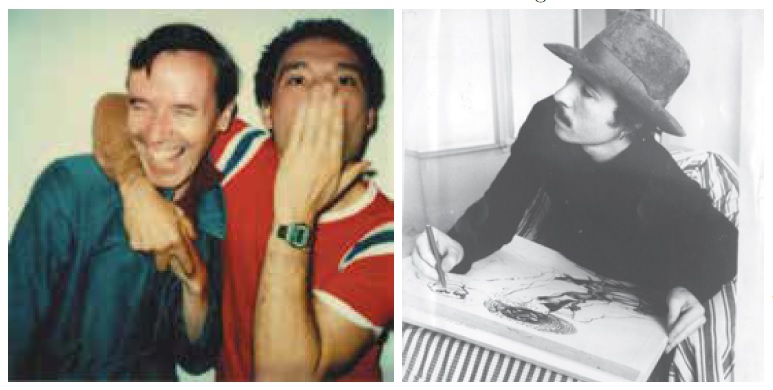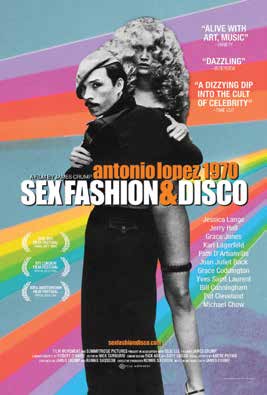 By Gary M. Kramer–
By Gary M. Kramer–
Bisexual fashion illustrator Antonio Lopez rose to prominence in the late 1960s/early 1970s with his vivid images of beautiful models. Jessica Lange, Grace Jones and Tina Chow all modelled for him, as did Jane Forth, Donna Jordan and Jerry Hall, whom he discovered. Lopez was close friends with the late Bill Cunningham (of The New York Times style section), and Karl Lagerfeld.
James Crump’s buoyant, if skin-deep, documentary, Antonio Lopez 1970: Sex, Fashion & Disco, opening October 5 in the Bay Area, captures the “magic” of this magnetic, charming and flirtatious man, who is described by several interviewees in the film as being “sensual,” “seductive,” “romantic” and “ahead of his time.”
It is easy to see Lopez’ appeal. Crump features hundreds of dazzling photographs and film clips of his subject, and the images of him drawing, posing and even mugging for the camera communicate his larger than life personality. When someone claims that Lopez “looked like a pimp,” photos of the artist sporting a red hat, jacket and pants, along with a cane, illustrate this idea. He also loved to dance. A series of photos bring his body language to life.

Antonio Lopez 1970 showcases much of the artist’s work using big, beautiful images full of sensuality and sexuality. “He drew the way he thought people should look,” one observer remarks. Joan Juliet Buck, the former editor-in-chief of Paris Vogue, describes the difference (as artist David Hockey explained to her) between “rendering” and “recording,” noting that Lopez did the former, and that is why his work is so extraordinary.
Frustratingly, several of the interviewees are not seen while they are speaking. This makes it difficult to determine the source of certain stories except through voice recognition. Many anecdotes are told by noted raconteurs. Jessica Lange provides an amusing account of how she re-connected with Lopez after he lost her number. Patty D’Arbanville remembers dancing and drinking too much with Lopez, and her enthusiasm is infectious.
 Bill Cunningham is particularly revealing in his storytelling. He recounts the night Lopez was unable to find the right model for a dress—even forcing Cunningham to try it on. Still unable to get it right, Lopez went out and found a hustler with the perfect body to wear the clothes in a way that would allow him to sketch it properly. Such was his vision and talent.
Bill Cunningham is particularly revealing in his storytelling. He recounts the night Lopez was unable to find the right model for a dress—even forcing Cunningham to try it on. Still unable to get it right, Lopez went out and found a hustler with the perfect body to wear the clothes in a way that would allow him to sketch it properly. Such was his vision and talent.
That vision and talent is on display throughout Antonio Lopez 1970. Jerry Hall is described as “the ultimate Antonio girl,” and his sketches belie this claim. Viewers may want to see even more of Antonio’s work, as the film focuses as much on his life as it does his art.
That life unfolds during the heady, early days of gay liberation. Max’s Kansas City was a place to be seen and dance, and Lopez and his entourage, which included models Pat Cleveland, Jane Forth and Donna Jordan, along with makeup artist Corey Tippin, congregated as a clique that rivaled Andy Warhol and his followers. As Lopez’s various friends recount their experiences—begging to get in the club or observing wild behavior (if not performing it themselves)—the film generates a nostalgia for the pre-AIDS, pre-Instagram era.
Crump reveals that Lopez was attractive to everyone he met. He slept with both women and men, but preferred men. He also maintained a 5-year relationship with Ramos, whom he met at F.I.T. The two students quit school together and embarked on a professional career that outlived their relationship. Ramos was refined and intellectual, and a formidable partner for the mercurial Lopez. Antonio Lopez 1970 gives Ramos his due, emphasizing his importance in their collaboration—even when the team went to Paris. Ramos’s role in Lopez’ life and career is so interesting that it could have been featured even more prominently in the film.
Instead, the talking heads shower Lopez with affection while interesting tidbits are clustered together to flesh out this portrait of the artist. There are discussions of Lopez being hypnotized to cure his inability to work; his near-marriage to Jerry Hall; his dancing at Club Sept in Paris and going off to San Tropez. There a few items about his family. His father was a psychic and his mother had difficulties with her son’s sexuality. Lopez is also described as being addicted to sex, by one interviewee. He eventually contracted AIDS. (Ramos did as well, dying eight years after Lopez.)
The documentary nevertheless presents numerous fond memories. Despite them, Antonio Lopez 1970 never delves very deep. Lopez’ fabulous life looks mostly fun and exciting. But Crump never really connects the dots to provide a greater understanding of the importance of Lopez’ contributions to fashion and culture. He just seems to revel in its superficial beauty. For some, that may be enough.
© 2018 Gary M. Kramer
Gary M. Kramer is the author of “Independent Queer Cinema: Reviews and Interviews,” and the co-editor of “Directory of World Cinema: Argentina.” Follow him on Twitter @garymkramer
Recent Comments